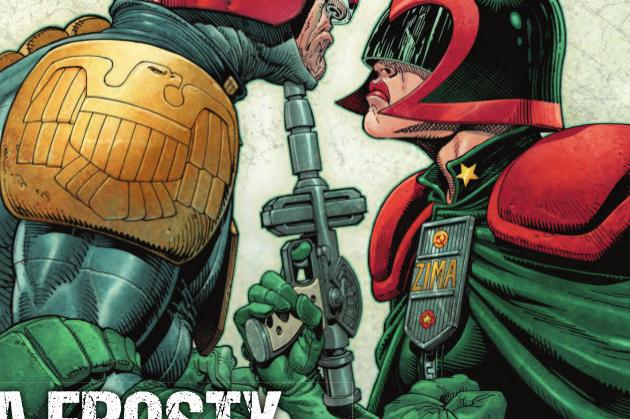2000AD, PROG 2058
Writers: Michael Carroll; Pat Mills; Gordon Rennie; Eddie Robson; Kek-W
Artists: PJ Holden; Simon Davis; Tiernen Trevallion; Steven Austin; Lee Carter; Cliff Robinson
Colourists: Quinton Winter; Gary Caldwell; Dylan Teague
Letterers: Annie Parkhouse; Ellie De Ville; Simon Bowland
Publisher: Rebellion
It’s a Mexican stand-off between the Americans and Russians in Judge Dredd: Black Snow. Leading a taskforce to liberate a Siberian refinery which has been taken over by angry locals, Dredd finds himself in an awkward position when the Sov-Judges finally showed up. Its unusual for Dredd to actually be caught on the wrong side of the law, and it’s a tense episode filled with close-ups as Dredd shifts from trying to avoid a diplomatic incident to trying to not get everyone killed.
Slaine: The Brutania Chronicles: Book Four: Archeon has crawled towards this moment. A story about the search for self and how the past can define us. Slaine’s epic quest to discover the secret of his parentage has brought us here, and in flashback we finally discover the truth. Just who is the baby-daddy? The art and drama here show what Slaine is capable of as a strip. Slaine’s plot and its often bizarre dialogue are really secondary to the canvas it gives artists, allowing them to draw monsters, muscles and bloody battles. Artist Simon Davis shines this issue with all three.
Absalom: Terminal Diagnosis: Book One takes a bit of a detour as we travel into Harry Absalom’s past to reintroduce his old boss. The Gov’nor is a monster of a man, whose only redeeming feature is his bond with Geoffrey – the cricket bat he uses to kill anyone who gets in his way. Absalom has been building characters for the past few episode, and the Gov’nor’s reintroduction is well handled, demonstrating the darkness of a man who may well be entirely evil but just happens to be on the human side in an ongoing conflict against Hell, and contrasting this in flashback with Absalom himself, who might break the rules but has a strong moral code. As ever, Tiernen Trevallion’s art is on top form, providing brutal violence which comes close to physical comedy.
As one of the ridiculously named “Tharg’s 3illers” (how do you even pronounce that? Is it “three-illers”?) The House of Gilded Peak will be a three parter, and possibly a pilot for longer term adventures. Essentially doing in three parts what a Futureshock does in one, 3illers (“threelers”?) can sometimes move at a leisurely pace and outstay their welcome. Part one sets out a fantasy kindgom and a plan to rob a magically hidden property by a gang of equally magical criminals. It’s a nice set up with some subtle details that will no doubt come into play soon. The format, however, makes it difficult to judge until we get at least another week in.
We’re nine parts into Indigo Prime: A Dying Art, and I’m sure that we will have lost several readers along the way. It's been a confusing adventure, filled with references to the previous series Anthropocalype which ran in 2013, picking up characters from the seemingly unrelated Revere which last appeared in 1994, as well as Indigo Prime characters who were last seen briefly in the eighties. Even without these elements, the plot of A Dying Art is often a conundrum, wrapped in an enigma, wearing a Slathersuit.
For those who have fallen by the wayside, take a moment, if you will, to just appreciate how beautiful this is. The script, now in the hands of the talented Kek-W, plays not only with the John Smith-style jumble of magical/occult/pseudo-science references, but is filled with small humorous moments, like the insistence that explanations should be given in “post-Trump English”, or quoting Star Trek memes. The art, by Lee Carter, can faultlessly go anywhere, from finely crafted and expressive humans, to wild psychedelic panels, to aliens, ghosts and epic battles. Even the lettering, by Simon Bowland, is perfect, with long flowing dialogue unobtrusively slotted into already full panels, with small details of slightly different balloon shape or fonts for certain characters, allowing the whole thing to simply flow.





